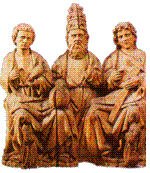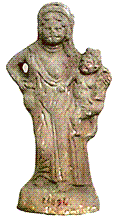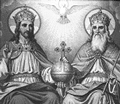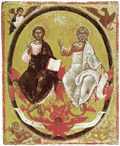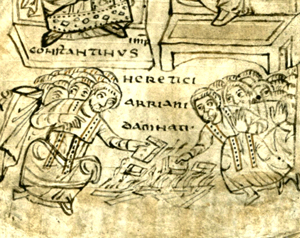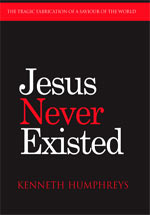The Trinity – An Evolving Nonsense
14th century depiction of the Catholic Triune God
Gosh! – 3 Heads, 4 Legs! Complete Rubbish!
In its original form Christianity was not Trinitarian: the term is nowhere in the Bible, was unknown to St Paul or to any of the ante-Nicene "Fathers" and flies in the face of monotheism.
Because of its hybrid nature, the riddle at the heart of Christianity was, on the one hand, how could a "redeeming sacrifice" – if less than a god – "atone for all of humanity's sins?"
But on the other hand, if the sacrificial lamb was really a god, could he then really have suffered and died on the cross?
Hence, the Trinity...
The Bishop who did not know of Jesus!
Theophilus of Antioch
(115-185)Theophilus, an early Christian apologist, in his work Theophilus to Autolycus – used the Greek word "trias" but he was NOT speaking of any Catholic Trinity.
In Book 2, chapter 15 he writes of "a type of Trinity – of God, His Word and His Wisdom."
He refers extensively to Jewish scripture but makes only passing reference to recent (and unnamed) gospels. He mentions neither apostles nor disciples.
This is consistent with – a rather startling truth – that Theophilus does not know of an historical Christ at all!
The bishop wrote 29,000 words without once mentioning Jesus Christ!!
•CHECK FOR YOURSELF
So Why was Theo' calling himself a Christian..?
This is how Theophilus explains the origin (in Antioch) of the word "Christian":
Chapter XII - Meaning of the Name Christian.
"And about your laughing at me and calling me "Christian," you know not what you are saying.
First, because that which is anointed is sweet and serviceable, and far from contemptible. For what ship can be serviceable and seaworthy, unless it be first caulked? Or what castle or house is beautiful and serviceable when it has not been anointed? And what man, when he enters into this life or into the gymnasium, is not anointed with oil?
And what work has either ornament or beauty unless it be anointed and burnished? Then the air and all that is under heaven is in a certain sort anointed by light and spirit; and are you unwilling to be anointed with the oil of God?
Wherefore we are called Christians on this account, because we are anointed with the oil of God."
("Christ" is not a name but a Greek rendering of the Hebrew "Messiah" meaning "the anointed one.")
OILING UP – Eat YOUR Heart Out, Jesus!
Befuddled Proles
"It is a strange experience ... to study these obscure congregations, drawn from the proletariate of the Levant, superstitious, charlatan-ridden, and helplessly ignorant, who still believed in Gods begetting children of mortal mothers, who took the 'Word', the 'Spirit', and the 'Divine Wisdom', to be persons called by those names, and turned the Immortality of the Soul into 'the standing up of the corpses'; and to reflect that it was these who held the main road of advance towards the greatest religion of the western world."
– Gilbert Murray, Five Stages of Greek Religion, IV. The Failure of Nerve, p165.
Isis in the process of becoming Mary (Upper Egypt, 4th century)
When Jesus was Just a God...
The Docetists said Jesus was God himself, temporarily disguised as a man...
1st - 5th centuries
When Jesus was Just a Man...
The Ebionites regarded Jesus as the chosen one:
"Christ a man chosen by God on whom the Holy Spirit rested and made divine."
1st - 5th centuries
No Trinity Here
'Mark' has his godman going off to a mountain and praying (Mark 6.46).
But to whom is he praying?
If he were part of the Trinity – 'True God from True God' and all that – he would be praying to himself!
Tertullian (160 - 220)
Tertullian, a bishop of Carthage, provided a hybrid theology, a 'missing link' between the one god nonsense and three god nonsense.
A severe, uncompromising man (virgins should be veiled; second marriage was fornication, etc.) he broke with the Catholics in Rome (about 211), both for their lax ways and because they were in the grip of "Monarchians" (the original one-god faction).
First with the "Montanists" (who said the Holy Spirit spoke through them) and then with his own sect, he developed a non-Catholic version of the Trinity.
Having read Theophilus's work, he rendered "trias" as "trinitas" in Latin. He worked out the semantic formula – 'three persons, one substance' but then went on to say that from all eternity there had been 'Reason' (Wisdom) and the 'Word' in God, but not as distinct 'persons'.
In the beginning, said Tertullian, Christ did not exist (hence, a lesser god!), but was a perfectly created being!
(By the way, he did not believe that Mary was a perpetual virgin!)
Two & a bit – The Holy Trinity
In the ancient world the dove was a symbol of the mother goddess, often used to represent female fertility and procreation.
Origen (182-251)
A self-castrating fanatic from Alexandria, Origen wrote prolifically but little of his work survived. He was condemned in 553 for heresy.
We know he speculated about a triad of Father, Son, and Spirit, but with the latter two entities subordinate and inferior to the Father. For his pains, he was charged posthumously with the "guilt of Arianism."
Origen had been influenced by Gnosticism and thought that Jesus appeared differently to different observers according to their spiritual capacities – a sort of cosmic shape-shifter.
Rather cutely, Origen said that even Satan could be redeemed.
Too much of a freethinker for his own good.
Two & a bit – The Holy Trinity
Coins from Ashkelon (1st century BC) use a dove to represent the goddess Tyche-Astarte.
Hippolytus (?180 - 235)
Hippolytus – an 'anti-pope' – argued that the Monarchian or 'modalist' doctrine of Pope Callistus was 'contrary to scripture.' (Callistus of course was the pope friendly with the concubine of Emperor Commodus.)
In pre-Trinitarian Rome, so-called 'modalism' (or, yet another name, 'Sabellianism') was the prevailing doctrine, holding simply that "Christ was a manifestation of God Himself."
Hippolytus, though condemned as a "ditheist" for his two-god theories, gained support from another 'anti-pope' – the puritanical Novatian.
Under pressure from his rivals, Callistus set out a revised formula. Thanks to the pen of an ex-slave and crook, an embryonic doctrine of the Trinity made its triumphant entry into the dogmas of the Roman Church.
By the time Athanasius arrived in Rome, about a century later, the Catholic Church was ready to accept his "mystical rationale" that the Father and the Son are one and the same in substance, a sort of square root of nonsense.
Two & a bit – The Holy Trinity
Like much else, the ancient symbolism of the dove was subsumed into Christian use of this pagan icon.
This Time its Personal...
'The mouths of communicants were held open by a wooden engine while the consecrated bread was forced down their throats, the breasts of tender virgins were either burnt with red-hot egg-shells, or inhumanly compressed between sharp and heavy boards.'
– Edward Gibbon, commenting on the hostility between Arians and Catholics.
(The Decline & Fall off the Roman Empire, 21)
|
|
||||||||||||||||||||||||||||||||||||||||||||||||||||||||||||||
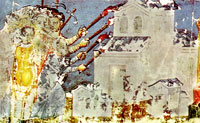 Dastardly Arians set fire to Catholic Church – 9th century Catholic propaganda. (MS Gr. 510 Bibliotheque Nationale, Paris) |
|
|
Arianism – Christianity's Last Link with Rationality
Scholars trained in the schools of Greek philosophy and rationality did not entirely lose their mind when they became Christian theologians. It was quite reasonable, therefore, for them to proceed from the concept of a single, universal creator god to the proposition that whatever else Christ may have been, he was less than the supreme god, a subordinate deity somewhere between man and the Almighty.
This, in a nutshell,
was the view of Arius, a theorizing presbyter
in 4th century Alexandria.
"A creation," said Arius, "is less than its creator. The Son is less than the Father that 'begot' him. In the Beginning was the Creator God and the Son did not exist."
It was a simple
theology, one that had a certain rationality and also the merit
that it could be readily understood. It showed the influence upon
Arius of Alexandrian neo-Platonism, and more particularly,
the speculations of Lucian of Antioch.
Borrowing freely from the lexicon of pre-Christian philosophers, Greek words like 'ousia' (essence), 'hypostasis' (substance), 'physis' (nature), and 'hyposopon' (person), were given new 'Christian' meanings by Arius and those who came after him.
Arius was an proficient orator, writer (his major work in 323 was "Thalia", later burned of course) and song writer! His sea shanties popularised his religious ideas in the coastal port cities.
But Arius had a much younger political rival and adversary in the shape of a fellow Alexandrian, Athanasius. Protégé of the then bishop (Alexander), Athanasius devoted himself to memorizing scripture and "the true science of the profound mysteries."
Theological
speculation was not Athanasius's strong suit but neither was he
bound by "scripture alone." Rather, he stood by belief and experience of
Divine Mystery, as interpreted in "the traditions of
the Church." He had no need for the logic of Greek
philosophers.
"Whereas philosophy could only persuade select and local cliques of immortality and goodness – men of little intellect have infused into the multitudes of the churches the principle of a supernatural life."
– On the Incarnation, 47.
Athanasius and "Divine mystery"
" 'Arianism' is the polemical creation of Athanasius above all, who was determined to show that any proposed alternative to the Nicene formula collapsed back into some version of Arius' teaching, with all the incoherence and inadequacy that teaching displayed." – R. Williams, Arius, p247.
The inspiration
for Athanasius's anti-rationalism was not the Alexandria of classic
Greek learning but Upper Egypt, home of cultic ceremonial and "ancient
mysteries." To this tradition, in the 4th century, were added
monastic escapees and ascetic hermits, like 'Paul of Thebes' and 'Antony
of Coma' (with whom Athanasius spent some early years). In
Upper Egypt, 4th century Christians were busy christianizing the
temples of the pharaohs, adopting that which they were not destroying.
|
Promoted above the venerable Arius, Athanasius gained the bishop's throne in 328 and held on to it (though half spent in exile!) for more than forty years. He defended to the last the right of the ecclesiasta to interpret God's Will – placing so-called "Church tradition" on a par with the Gospels.
Throughout his tumultuous life – and he was banished by no fewer than four Roman Emperors – Athanasius clung tenaciously to the doctrine that Jesus Christ was God (just like Horus, son of Osirus, was God.) The one true God made apparent his Will, Word, Wisdom, what-have-you, through 'emanations' and Christ was such an emanation. Squaring this particular circle – monotheism and yet Christ as god – required a peculiarly illogical ("mysterious") formula – but then Egypt was just the place to find such a formula. Athanasius returned repeatedly to Upper Egypt, hiding among the monks during times of exile (356 - 61; 362 - 63; 356 - 66).
The Egyptians had always deified these emanations, typically grouping them into trinities (in fact, a whole hierarchy of trinities). Thus, Isis-Horus-Set, Amum-Maut-Khonso, Atum-Shu-Tefnut-Mahet, etc., etc., reigned for thirty centuries, an eternal godhead.
The key aspect for the Egyptians (and Athanasius) was the god/human interface. "Begotten, not made, of one essence with the Father" was a traditional Egyptian mode of including a man-god within the greater godhead. The pharaohs stepped into the trinity on Earth (as Horus) and became the heavenly element (as Osirus) after death. Athanasius wrote:
"The Word, then, visited that Earth in which He was yet always present... Coming as God and as Man... Revealing Himself, conquering Death, and restored to life."
– On the Incarnation
Thus the religion of the Pharaohs was recast in Christian form.
Athanasius's
major literary contribution to the world was a work of fantasy,
equal to that of the 'Incarnation', the 'Life of Antony,' a
model of inventive hagiography. This fiction was to inspire such
luminaries as Jerome and Augustine in their own "lives of
saints." The Life, a paean to asceticism and the power
of the Lord's name, is awash with "demons" and "miracles."
"And rising up he saw a beast like a man to the thighs but having legs and feet like those of an ass. And Antony only signed himself and said, 'I am a servant of Christ. If thou art sent against me, behold I am here.' But the beast together with his evil spirits fled, so that, through his speed, he fell and died. And the death of the beast was the fall of the demons. For they strove in all manner of ways to lead Antony from the desert and were not able."
– Athanasius of Alexandria (Vita S. Antoni, 53)
The Egyptian
desert had always been feared as the home of 'demons.' Christian
ascetics – inspired by Antony's example – now swarmed
over the desert to battle the demon – and in so doing, infused
nascent orthodoxy with a demonology that would invoke such bloodshed
and horror in the European Middle Ages.
 |
|
The
Struggle for "Orthodoxy"
"The enmity of the Christians towards each other surpassed the fury of savage beasts against man."
– Ammianus Marcellinus
Arius had been
forced to flee Alexandria in 319. First in Palestine and then in
Roman Asia, he rallied support from fellow "Lucianists",
including the senior bishops Eusebius of Caesarea (the Church historian),
Eusebius of Nicomedia, and Valens, Bishop of Mursa. Synods convened
in Palestine and Bithynia opposed synods convened in Egypt. During
several years the argument grew more vicious and violent.
At this stage, there was no universally recognised orthodox creed. The answers to such questions as 'How divine was Christ?', 'How far was he human?' were still a matter of contention. Orthodoxy as yet was not rigidly demarcated. The Christian 'civil war' was not the story of the defence of orthodoxy, but the struggle to determine orthodoxy. Murder and mayhem would characterize its resolution, as would every base human motive masquerading under the banner of religion.
|
Rivals in every sense, Arius and Athanasius shattered any hopes Constantine may have entertained of a united Christian Empire. Exasperated by their obduracy he convened the first "universal" (ecumenical) Church Council and demanded an agreed ("orthodox") creed.
Convening at Nicaea in 325, for several months the theologians wrangled. Emperor Constantine had had enough. After personally struggling with dimly understood nuances of Greek theology – and taking counsel from the Spanish prelate Ossius of Cordova – this pagan thug and murderer proposed the formula which expressed (his idea of) the precise relationship of Christ to God: he opted for "of one substance" (in Greek 'homoousion').
Thus was it determined that "Jesus of Nazareth" had, in fact, been God Incarnate, the infinite creator of the universe. No mere carpenter, temporarily filled by 'Divine Essence', this new god of the Romans was no less than the eternal King in Heaven.
Overawed by the master of the world, the assembled bishops (with only two exceptions) endorsed "the creed."
High Summer of Arianism
But many churchmen were unhappy with this "two god" formula. Arius, sent into exile, travelled widely in the east and gained many supporters. Constantine remained far from clear just what he believed. When Ossius fell from favour Arius returned to it.
|
He submitted to Constantine a creed which the emperor judged to be orthodox and a contrite emperor ordered that Arius should receive the holy communion in the cathedral of Constantinople.
Murder of Arius
On the very day which had been fixed for his triumph, Arius died suddenly and under strange circumstances. "His bowels suddenly burst out in a privy." says Gibbon, the cause a choice "between poison and miracle."
Arius had been eliminated but a vexed Constantine turned his wrath on the Athanasians. Though Constantine's Council of Nicaea was ever after hailed as the lodestone of Catholic Orthodoxy, Constantine himself died as a baptised Arian in 337.
After his death, the imperial family remained divided on the issue and a blood purge ensued. The victor and probable murderer, Constantius II, took the eastern throne at the age of 20, with Arian clergy swaying his simple, superstitious mind. For a generation, Arianism would prevail and Catholicism stumbled.
Athanasius, outmaneuvered, retreated to Rome, accompanied by monks from the Egyptian desert. Athanasius’ exile in Rome brought Pope Julius I into the struggle. He called a council favourable towards Athanasius at Sardica in 343 but this council was avoided by the Eastern bishops and ignored by Constantius. It got worse.
By 350, with his two brothers dead, Constantius' writ embraced the whole Roman world. Arian bishops commanded important sees throughout the empire, most importantly at the imperial cities of Milan and Constantinople.
Yet fatally for the cause of Arianism, speculation encouraged further speculation. Council followed council (14 were held between 341 and 360) "in which every shade of heretical subterfuge found expression..." (Catholic Encyclopedia).
The Arians broke into diverse groups according to which term they supported - 'anomoios' (dissimilar), 'homoios' (similar) or 'homoiousion' (like in substance).
Favourites moved in and out of court circles with alarming frequency. The empire's resources were drained by the navel gazing.
Beardless Jesus gets his Arian baptism – and pagan river god looks on! 5th century 'Arian' Christian baptistery ceiling, Ravenna. |
Attempts to resolve Arian differences were made at Sirmium (351, 359). The final formula was an ambiguous 'homoean' ('of like substance') declaration that Constantius forced on the church in two councils, Rimini (for the West) and Seleucia (for the East) in 359. This 'homoean' victory was confirmed and imposed on the whole Church by the Council of Constantinople in the following year.
Said Jerome after the Council of Rimini:
"The whole world groaned and marvelled to find itself Arian."
The Catholics were left dependent on Rome for support.
At first, the obstinate Bishop in Rome, Liberius, was forced into exile but subsequently he regained his lucrative see by subscribing to the Arian creed – in so doing gaining everlasting opprobrium from Catholics as "a heretic pope." Other Western bishops, like Hilary of Poitiers, Ossius of Cordoba and Eusebius of Vercellae were banished to Asia, though they maintained contact with other renegades like Basil and the two Gregories.
As the war dragged on, rival Arian and Catholic bishops fought each other in the streets. The wily pagan emperor Julian (360 -63) encouraged all exiled fanatics of the Galilean to return home in the fond hope that they might destroy each other. In Alexandria, where the dispute began, that largely happened.
Erstwhile bacon salesman George of Cappadocia, a grandee of the Arians – and future St George of England! – seized the bishop’s chair when Athanasius was driven into the desert. So incensed were the inhabitants by his persecutions that they took their revenge on George by throttling the bishop and dumping his body in the sea.
Catholicism – "Talismanic
Mysteries" the path to Power
"The West, which remained free from controversies of an abstract nature, and was faithful to the creed of its baptism.
Intellectual centres were chiefly Alexandria and Antioch, Egyptian or Syrian, and speculation was carried on in Greek. The Roman Church held steadfastly by tradition ...
From these doubtful theorizings Rome kept aloof."
– Catholic Encyclopedia
Athanasius, exiled
first to Gaul (335-337) and then to Rome (339-346), took with
him the notions that would become the Catholicism in the west.
It meant his understanding of what had been "agreed" at
Nicaea; the precepts of monasticism; and unrestrained nonsense
relating to demons and miracles.
He entered a fertile ground. Latin did not lend itself to subtle distinctions of theology nor was there any Greek tradition of philosophical discourse. The west produced no theologian of note before Augustine in the fifth century. In Italy and the untutored western provinces, relics, demonology and miracles made far greater sense.
Athanasius died in 373 but his dogmas had been enthusiastically taken up by the popes.
The Trinity – Why adopt such a 'difficult' dogma?
Two things distinguished the Catholics from their Arian opponents: one political, the other doctrinal. Politically, the eastern sees, though each preserving a limited degree of autonomy, were ultimately subordinate to imperial control. The Patriarchy in Constantinople was in the gift of the emperor and functioned as a department of the state.
In contrast, the Popes in Rome increasingly saw themselves as independent of, and ultimately superior to, any secular authority. Sees in the west became thoroughly subordinate to the Bishop in Rome. In short, Catholicism was a tightly disciplined structure of power and wealth, rivaling the state.
Doctrinally, Catholicism kept aloof from fruitless "Christological" speculation on the nature of the god-man. Its call was for unity around an unfathomable mystery.
Stop thinking, Believe!
Instead of theology it opted for a legitimising stratagem of bones and miracles. Roman Catholicism, with no authentic links to the Galilean saga, was building its power base on spurious claims of "signs and miracles."
That shadowy "third person" of the trinity – the Divine Wisdom or Holy Spirit – could be identified with many things – not least with "the communion of saints", the institution of the church itself, a new visible "city of God" on earth. The fantastic nonsense of the Trinity set Catholicism free of all restraint.
With the 'Holy Spirit' let loose all manner of wonderful events could occur at the behest of the Catholic bishops. Literally, the magic of the Holy Spirit, was made live and well, beavering away on behalf of the Bishop of Rome and his henchmen.
Ambrose Prevails
The elevation of the soldier Valentinian I in 364 brought a Catholic to the throne in the West, though not a particularly devout one. But it was he who brought Ambrose (city boss of Milan) to the fore. Ambrose persuaded Valentinian's son, the young caesar Gratian, to depose six Arian bishops and enact a series of laws between 379 and 380 prohibiting Arianism in the West. The argument was settled, as ever, by force.
With Gratian dead at 24 Ambrose moved on to his younger sibling. In the hands of Ambrose the 'Trinitarian creed' was developed to inform the dim witted Valentinian II, a child otherwise under the influence of his Arian mother, the Empress Justina. The naked power struggle between politico bishop and Regent masqueraded as a theological dispute on the nature of the godhead. A mob animated by some convenient martyr's bones settled the matter.
The Trinity, "that unfathomable mystery", had become the central doctrine of Roman Christianity, enforced on pain of death. After a generation in the doldrums Catholic "Orthodoxy" – triumphant in the west – now got its comeback opportunity in the east.
In 381 the Spanish fanatic Theodosius I and a mob of rumbustious bishops arrived in Constantinople from the west. The new pious Emperor outlawed Arianism (and everything else of which he disapproved) throughout the empire.
At the Council of Constantinople it was proclaimed that not only was Christ god – but that the Holy Spirit was god too! The bishops and their emperor declared that mysterious entity, flexible yet bafflingly obtuse, a fully paid up member of the godhead, thus giving the Roman world a triune god – three versions of nonsense rather than one.
Early in the 5th century the Trinitarian dogma was re-labelled the "Athanasian Creed", in honour of the original fanatic who had preferred Egyptian mysteries to Greek philosophy.
(In later centuries, the rather woolly concept of the 'Holy Spirit' would be upstaged by the altogether more visual 'Mary Mother of Jesus'. The Trinity itself would give the 'Scholastics' of the Middle Ages a lifetime of leisured theorising).
Arian Twilight
When Roman captives, gold or troops passed beyond the northern frontier, Arian Christianity went with them. As early as the 360s some of the Vandal tribes had acquired Christian talismans and from them the trinkets of Christ passed to remoter tribes. Famously, a Roman monk of Gothic ancestry – Ulfilas – set his hand to rendering his own written form of the Gothic tongue and translated parts of the Bible – which one presumes might have been read to the illiterate tribesmen. Or maybe not. By the 370s, Arianism had been adopted by the Goths and spread from them to nearly all the German tribes.
During the migrations and invasions of the 5th and 6th centuries, the barbarian kingdoms which arose on the fallen empire of the west, were almost all of Arian persuasion. Arianism served each in the same fashion it had served Constantinople under the Arian emperors: as a 'national' religion, in embryonic form potentially a 'department' of a 'national administration,' with bishops chosen by kings. The very notion was anathema to the 'universal' persuasion of the Catholics whose grand design was for ecclesiastic not secular power, under the international authority of a papal monarch in Rome.
The one exception was a barbarous tribe from the marshlands of the Rhine – the Franks – who became the favoured sons of the Catholics. The symbiotic relationship between the Catholic bishops and the Frankish warlords brought both to the mastery of Western Europe.
Sources:
Chris Scarre, Chronicle of the Roman Emperors (Thames &
Hudson, 1995)
Robert Graves, Count Belisarius (London, 1938)
Rowan Williams, Arius (SCM Press, 2001)
Arthur Ferrill, The Fall of the Roman Empire (Thames & Hudson,
1986)
Helen Ellerbe, The Dark Side of Christian History (Morningstar
& Lark, 1995)
Richard Fletcher, The Conversion of Europe (Harper Collins, 1997)
Edward Gibbon, The Decline & Fall of the Roman Empire (1799)
Michael Grant, The Climax of Rome (Weidenfeld& Nicolson, 1996)
Michael Grant, Fall of the Roman Empire (Weidenfeld& Nicolson,
1996)
Robert Wilken, The Christians As the Romans Saw Them (Yale UP,
1984)
Robin Fox lane, Pagans & Christians (Viking, 1986)
|
||||||||||||||||||||||||||||||||||||||||
|
|
|
||
Copyright © 2004
by Kenneth Humphreys.
Copying is freely permitted, provided credit is given to the author and
no material herein is sold for profit.
